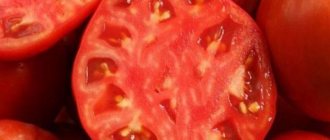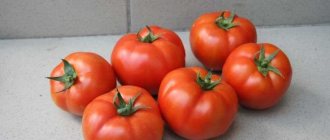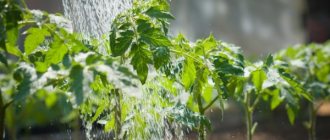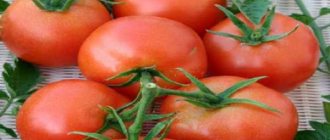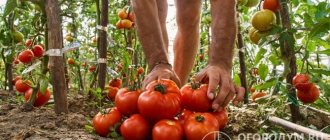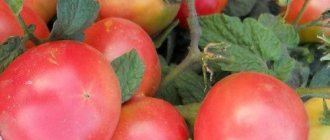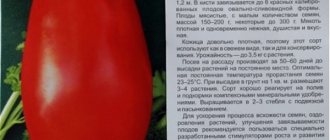The Dubrava tomato has a second name, by which it is no less known - it is Dubok. The variety is included in the register. Recommended for planting in the Volga-Vyatka region and the Central zone.
| Height | Landing location | Ripening time | Fruit color | Fruit size | Origin | Fruit shape |
| short | Greenhouse, Open ground | Early ripening | Reds | Average | Variety | Flat-round |
Description and characteristics of the variety
When choosing a variety of tomatoes to plant on their plot, gardeners first of all look at whether they can be grown directly in the open ground, and not in greenhouses. It is also advisable not to waste time removing stepchildren or tying up bushes. The Dubrava variety has precisely these qualities.
- The plant belongs to the determinant type, standard. It grows in height up to 50-65 cm. One bush occupies an area measuring 30:40 cm. It has such compact parameters that some housewives grow it on balconies and even on windowsills.
Important! Due to their small size, the bushes do not need to be tied up. Also, they do not need to remove the stepsons.
- Dubrava is an early ripening variety. The first fruits fully ripen in 80-95 days from the moment of emergence.
- The bushes form 3-4 stems, branching is weak.
- The leaves of the plant are small and light green in color.
- The variety does not like dry soil, so the plants must be watered regularly.
- The first flower clusters appear above the 6-7th leaf, the next ones are formed every 2 leaves.
- Tomatoes are resistant to nightshade diseases. However, it is recommended to regularly treat the bushes with special preparations in order to prevent the disease.
- The tomato yield is quite high. If you follow all the rules for growing and caring for tomatoes, you can harvest up to 2 kg or more tasty fruits from one bush. It all depends on the weather conditions of the region and the composition of the soil.
Advice! The Dubrava tomato variety produces the best yields when grown in the southern and central regions of the country.
Outdoor care
Planting tomatoes of the Dubrava variety in open ground begins with choosing a place for the garden bed. The plant is not capricious in relation to the composition of the soil. But it feels better and develops easily on sandy and loamy soils. The soil must be fertile.
You cannot plant tomatoes in a garden bed where related crops previously grew. A pathogenic background accumulates in the soil, which means plants will experience oppression by fungi and other pests. It is better to observe crop rotation in the garden and plant tomatoes after cabbage, onions or cucumbers. The bed is prepared in advance by removing all weeds. Extra plants are an excellent place for harmful bacteria and fungi to develop and multiply.
Tomato seedlings “Dubrava” are planted according to a pattern prepared and marked in the garden bed in advance. To save space, bushes are planted in a checkerboard pattern. Maintain a distance of at least 60 cm between the rows. This will be comfortable when ventilating the tomatoes. The distance between the bushes is also maintained. It depends on how you plan to grow tomatoes. If there is one stem, then the distance is 25 cm, if there are 2-3, then maintain 35-40 cm between plantings.
Caring for Dubrava tomatoes is very simple. The culture is not whimsical and does not lose productivity even with minimal care. Watering tomatoes is not necessary at all if the summer is rainy. Also, you should not do them every day in the heat. It is better to navigate along the top layer of soil. You need to water the plant when it dries out. The next day after evening watering, the soil is loosened
This is important for the breathability of the soil and to prevent a crust from forming.
When maintaining, remove weeds periodically. To retain moisture, you can mulch the plants with a layer of peat. A garter is needed if the stems are overloaded with large fruits. In this case, the fruits will not come into contact with the ground and rot, and this will also prevent breakage of the stem and disruption of sap flow in the shoots.
Pruning "Dubrave" is only necessary if you want to grow a crop with several stems. Particularly large harvests are produced by plants with three stems. To do this, tear off the stepsons in the two lower nodes with your hands, leaving a stump.
Fertilizers are applied throughout the growing season, but only based on phosphorus and potassium. Avoid excess nitrogen. Because of this, the fruits become small and the stems become elongated. Nitrogen-containing fertilizers are applied only at the beginning of the formation of tomatoes.
Look at the video description of the Dubrava tomato variety and tips for growing it in open ground:
Fruit characteristics
- The fruits are round in shape and, when ripe, red in color with a glossy tint.
- The tomatoes are fleshy, with a rather pleasant taste.
- The weight of one fruit can vary from 75 to 85 g. But individual specimens weighing more than 100 g can be found.
- Under good conditions, the average yield of the variety can reach 4.5 - 5.5 kg per 1 square meter area.
- Tomatoes keep well when ripe. During transportation they do not crack or lose their appearance, and can also withstand long-distance transportation.
Advantages and disadvantages
The advantages of the variety include the following:
- Early ripening variety. This makes it possible to collect ripened fruits in any region before the arrival of the first frost.
- The taste of tomatoes is quite good.
- Tomatoes are suitable for any type of consumption and preparation.
- The fruits all ripen at the same time.
- The plant is very compact and unpretentious.
- Grows well in open ground and does not require shelter.
- Average resistance to late blight and some diseases.
Flaws:
- Despite the fact that the Dubrava variety was created for growing without shelter, the seeds cannot be sown in open ground. Tomatoes are grown only as seedlings.
- High tomato yields can only be achieved with a certain soil composition and warm climate.
Features of cultivation
Depending on the climatic characteristics of the region in which the Dubrava tomato variety is grown, the sowing of seeds is different. Before planting ready seedlings in a permanent place, seeds are sown 50-60 days in trays with a nutrient mixture. Typically, this procedure is carried out from mid-March until the end of the month.
Some experienced gardeners prepare the soil for planting tomatoes themselves. But you can buy ready-made substrate in special stores. Plants prefer loose and well-fertilized soil. At the same time, it should retain moisture and allow air to pass through for as long as possible.
Before you start sowing the seeds, they need to be kept for several hours in a weak solution of potassium permanganate for disinfection. And in order for the seeds to germinate faster, they must be treated with the growth stimulator Zircon.
When growing seedlings on a windowsill, it is important to prevent the soil in the containers from drying out, as well as from excessive waterlogging. When the first 2 strong leaves appear on the sprouts, they are picked into separate cups. At the same time, the first stage of feeding the plant is carried out. It consists of complexes of mineral elements. Next time, mineral fertilizers are also applied before the tomatoes are transferred to a permanent place.
Before planting seedlings in open ground, they need to be hardened off 2 weeks in order for them to take root painlessly in the new conditions. To do this, during the daytime the seedlings are kept at a temperature of 18 degrees. At night, the trays are taken out to a cool place with an air temperature of up to 12-13 degrees. In regions where daylight is still short at this time, additional lighting must be used for tomato seedlings.
For tomato bushes, you need to choose the right planting location, then the yield will be pleasing. When choosing a site, you need to consider the following points:
- It is better to plant tomato seedlings in the place where onions, herbs, cucumbers, carrots, and legumes were planted last year;
- the ground on the site should already be warmed up;
- there must be sufficient sunlight;
- the soil is loose, fertilized with good ventilation of the roots.
Also, you should follow all the rules for planting plants directly in the ground. The planting scheme for determinate plants has a single standard - 40x60 cm. First, holes are dug and treated with a manganese solution, thus protecting the soil and bushes from various infections.
The plant is buried so that the stem with the first two leaves remains high above the ground. This planting method will allow the tomato roots to grow freely and receive the right amount of air. In addition, the plant will be able to properly eat all the nutrients.
In order for the seedlings to take root well after planting, they are not watered for the first 7-10 days. If during the days of adaptation of the shoots the weather is hot and the sun is very hot, then it is better to shade them. When the seedlings take root and become stronger, young leaves will begin to appear. Now you can begin to form a bush of 2-3 stems, and remove the remaining stepsons. This procedure can increase tomato yields. In addition, the plant does not need dense green mass.
Despite the fact that the Dubravka tomato variety is an unpretentious plant, you still need to take care of it in order to get tasty and high-quality fruits. The soil under the bushes must be weeded as needed and watered regularly, especially in dry summers. Also, do not forget to loosen the soil in a timely manner and feed it with the necessary fertilizers.
If you suspect that tomatoes are infected with a fungus or late blight, you should immediately treat the plant with a special agent for the purpose of prevention. Check bushes often for pests. When the first pests appear, immediately take measures to destroy them.
More information about growing tomatoes is described in the article: Technology of growing tomatoes. Secrets of planting and care
You might be interested in: How to properly plant tomatoes in a greenhouse: bush formation diagram, care features, photos and videos
Useful information: How to properly tie tomatoes in open ground: the best methods, step-by-step photo and video instructions
Landing
This variety of tomatoes is grown in seedlings, without requiring complex manipulations.
Growing seedlings
The sowing date is determined based on climatic conditions; it must wait 60 days before planting in the ground. Usually this is March. In cooler weather conditions, sowing is carried out in April.
First, the seed is soaked in a weak solution of potassium permanganate or in special solutions to increase germination. The container you use must have holes so that moisture does not stay in for a long time.
The seed is sown on the prepared soil and watered; it is necessary to cover the container with glass to retain moisture. The first shoots should appear within a week.
Required care:
- it is required to provide lighting for 12 hours a day;
- watering should be done with warm water, it should not sit in the soil for a long time, but the soil should not be allowed to dry out;
- the temperature in the place where the containers are located must be stable; they should not be placed next to heating appliances and windows;
- feed with complex fertilizers.
Picking
When the first two leaves appear on the seedlings, they should be transplanted into new containers with greater depth, increasing the distance between them, at the same time they should be fertilized with a mineral complex. Then you will also need to fertilize them before transplanting them to a permanent place, using microelements.
Landing in the ground
The choice of time for transplanting into the ground is important; climatic conditions are taken into account. If the transplant is carried out in a greenhouse, then it can be done in April. If you plan to replant in open ground, then focus on the period when frosts are no longer expected. It is also worth waiting 60 days from sowing seedlings.
In open ground
The best option for planting would be sandy, loamy soil, dug up and free of weeds; it should be fertilized with solutions containing nitrogen and potassium.
Disembarkation stages:
- the holes made are watered with a solution of potassium permanganate; it is better to plant 3-4 bushes per 1 square meter;
- the roots of the seedlings are placed evenly and some at an angle, the first part of the leaves should rise above the ground by 2-3 centimeters;
- water at the root, being careful not to get on the leaves;
- provide protection from sunlight, wind, and drafts. You can cover them with film.
To the greenhouse
Transplantation into a greenhouse is possible if the temperature in it remains 18-20 degrees. The steps are similar to those of transplanting into open ground; it is possible to use garters, since bushes can grow up to 70 centimeters in these conditions.

